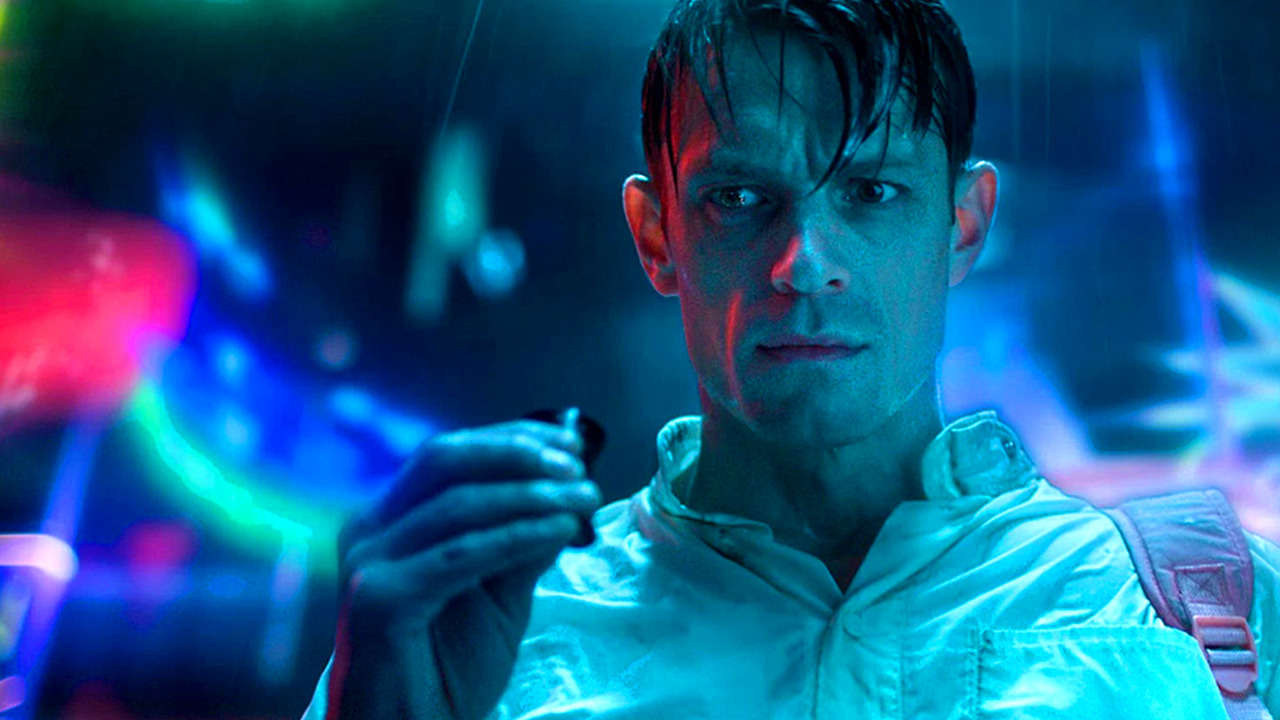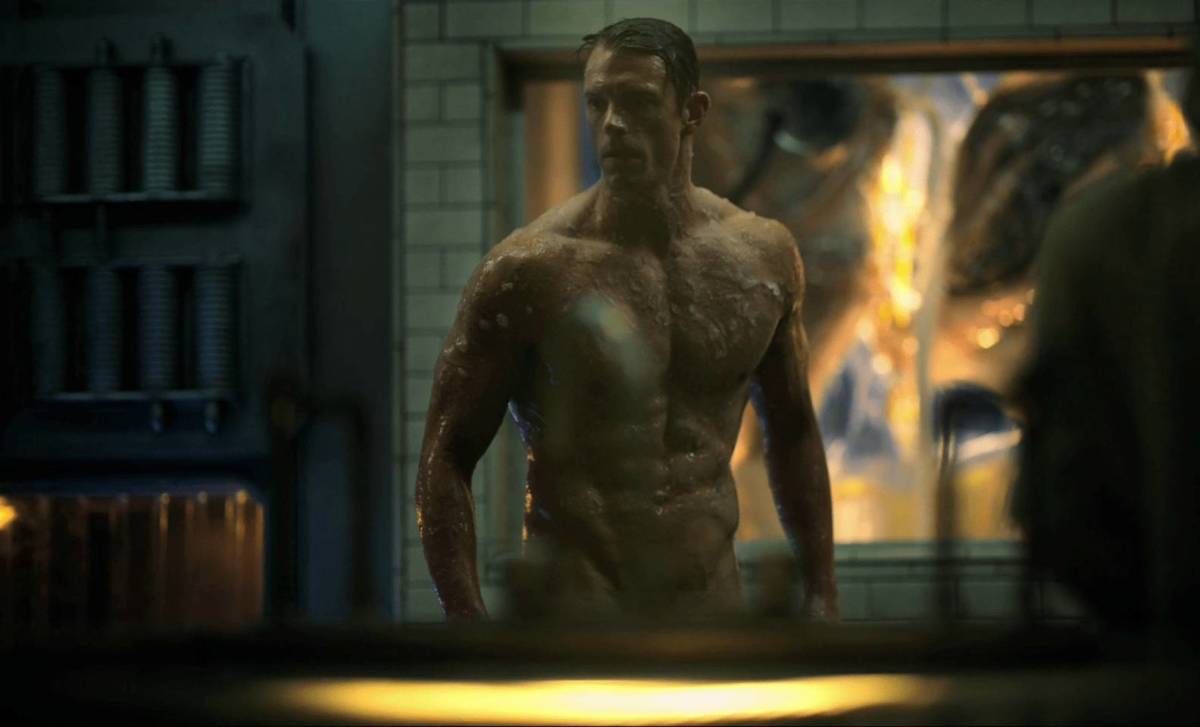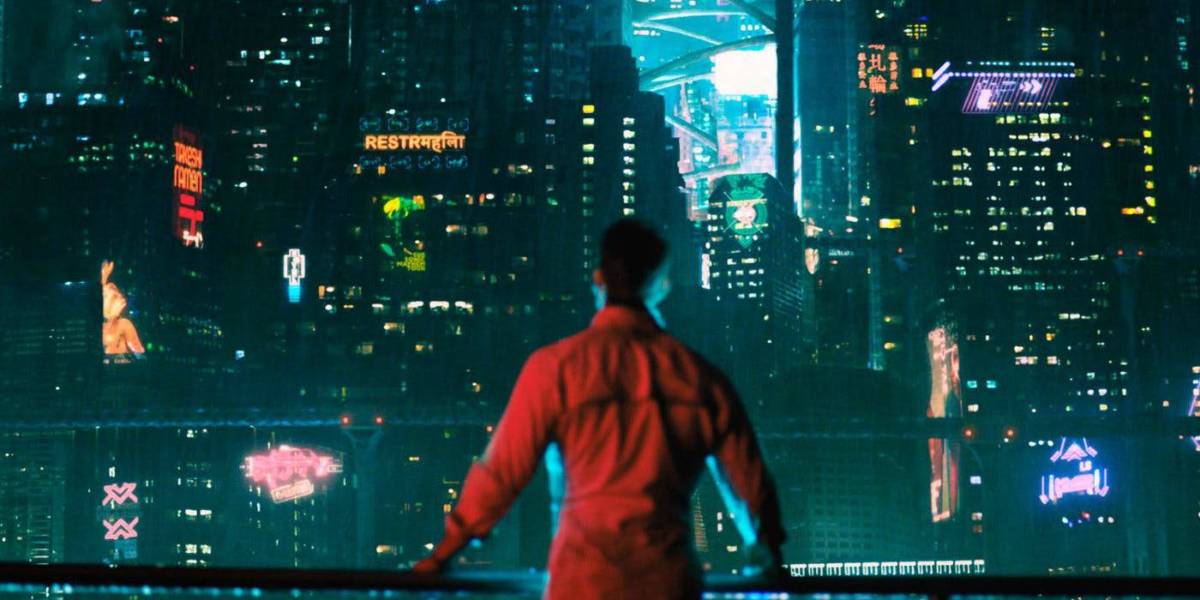Now we all know that Takeshi Kovacs died in that hotel room… but what this show presupposes is… maybe he didn’t?
As far as first episodes go, Out of the Past fares surprisingly well. Better than I’d have expected, frankly. It introduces us to the world it’s building, slaps some nametags on the roster of tall, beautiful actors who will inhabit it (there’s not a bad butt among them – not one!) and even hints at the kind of subtext writers like me get jazzed up to write about. Sure, the majority of Altered Carbon seems a derivative rehash of threadbare sci fi tropes – a cyberpunk mixtape of labyrinthine supercities, moral ambiguity, and even a pseudo-philosophical warrior class bent on upending an oppressive regime – but it introduces some riffs on those themes that could prove interesting in the episodes to come.
I’m experimenting with positive thinking here. Join me, won’t you?
Behold, The Gist 
What do we really need to know in order for this story to work? Actually, quite a bit. So, in the interest of clarity, here’s a breakdown:
Sometime in the future (how long has yet to explained) human beings develop the ability to digitize human consciousness and hardwire it into a data chip called a “stack.” Stacks are basically glowing poker chips, and elicit a hollow, delicious report when flung into a pile. (I’ve got a thing for sounds. Don’t ask. Anyway…) With a freshly minted stack, a person can upload their consciousness into a near-endless litany of bodies referred to as “sleeves.” I don’t know what sound sleeves make when hurled into a pile, but I’m betting it’s not nearly as pleasant. I’ll let you know in a few episodes.
So what’s the upside to all this? Humanity has essentially cheated death. The downside: supply and demand. Immortality of the mind has crashed the body market, and our physical forms have been reduced to valueless conveyances. You’d think a lifetime of lifetimes would give people a chance to learn something, maybe gain a little wisdom. But no. We got a free pass on mortality, but somehow life got even cheaper.
“Cheap” is a relative term, of course. In this future, the rich live on in perpetuity, cozy their own cloned skin. For the poor, however, a new body is doled out with the insouciance of government cheese. In one of Out of the Past’s best side-notes, a seven-year-old girl is resurrected into the haggard body of a 50-year-old woman and reunited with her bewildered parents – both of them at least two decades her junior.
Were it up to me, Altered Carbon would follow this story through the entire season. I have no need for guns and slo-mo kung fu when there’s existential tragedy and body horror to explore. But nobody at Netflix has returned my calls. Yet.
Meet the new hoss, same as the old hoss

It’s into this world that our anti-hero, Takeshi Kovacs, is born. Or, reborn, I suppose. Played by at least two actors – in the past by Will Yun Lee, and later resurrected into a giant wall of pale, sullen meat played by Joel Kinnaman, Kovacs is a former terrorist/freedom fighter who died battling against the very forces that now control the entire human domain. 250 years spent in a digital purgatory later, he’s dragged back into the soulless, capitalist nightmare he apparently died trying to prevent.
Kovacs is our lens into the story…and is hands down the least interesting part of the show thus far. This is due mainly to the limitations of Kinnaman’s listless portrayal, though in fairness, Kovacs is a wafer-thin archetype. He’s not so much hardboiled as overcooked. Alienated and bereft, Kovacs drifts through the winding streets of a society that’s gone metastatic, eye-dropping technodrugs and croaking cheap, cynical wisecracks at the local gumshoe, Kristin Ortega (a peppery and pugnacious Martha Higareda). Occasionally, he lapses into conversations with the phantoms of his past – his sister Rei (Dichen Lachman) and the improbably named Quellcrist Falconer (Renée Elise Goldsberry of Hamilton fame), Kovacs’ former lover and tutor. It was Quell (Really? That’s her name?) who trained Kovacs and his former compatriots in the subtle art of the Envoy.
It’s those very skills that have summoned Kovacs back into the world. Barely had he time to hose the amniotic goo from his flanks before he’s whisked far above the murk and mire of the city and into the moneyed sky palace of the mysterious Mr. Laurens Bankcroft (played with haughty oiliness by James Purefoy). Bankcroft is a wealthy megacapitalist power broker, and one of Altered Carbon’s precious Meths (short for the biblical nonacentenarian Methusula) capable of living forever in a series of clones of his original body. He even backs up his memories to an orbiting satellite every 48 hours. Bankcroft has it all – has had it all for nearly a millennium. He’s a guy quite keen on living – so naturally he’s insistent to learn who it was that murdered him.
Bankcroft reveals that at some point in the previous two days, someone snagged a gun from his safe and fragged not only his head, but his mind as well. Bankcroft was killed before he backed up, and thus has no memory of the previous two days. So he takes the next logical step: he has a 250 year old dead terrorist resurrected and leased to him as his own private, private detective.
Solve my crime, he says, and you can keep the body. Or a new one! And money. Lots of money. Anything you want, really – I’m super rich.
This is my favorite part of the story thus far, not only for its foregrounding the theme of the eroding dehumanization of class and power, but for the zag it brings to the tired tropes of noir. Classic detective stories often revolve around a murder investigation – some gorgeous femme fatale flutters into a shabby office and pleads with the worldworn dick to find the man who killed her sister – only in this case, the corpse the one doing the asking. You can almost hear the elevator pitch of this story. Guh. I love it.
It’s clear that Bankcroft investigation will lead to deeper and darker mysteries in the forthcoming episodes… and hopefully this will allow for many a long and silken monologue from James Purefoy. I just adore watching that man act.
Plenty of Room at the Hotel Amontillado
https://www.youtube.com/watch?v=dhFM8akm9a4
Kovacs scoffs at Bankroft’s offer, naturally. He insists that this world isn’t his world – then he wanders off into a period of sullen self-pity unbecoming of a man over 6’. His mopeabout leads him into a bonkers B-story about a lurid sex hotel overseen by an effervescent A.I. popinjay we’re asked to think looks like Edgar Allen Poe (he doesn’t)… and a slo-mo gunfight with a Russian gangster played by Battlestar Galactica’s Tamoh Penikett.
It’s mostly filler, but it’s filler that includes Edgar Allen Poe and a shotgun.
Safe on the roof, in the apre-fracas, Kovacs goes full Hamlet – dithering over his would-be suicide with a pistol at his neck. To frag or not to frag lacks a certain ring. He’s visited again by the phantom of his former lover who insists he do what he was trained to do – remain, persist, and fight. For whom or for what, though? That’s still unclear.
Altered Carbon has a lot going for it – it’s production values are high, it’s absolutely gorgeous to look at, and it’s playing at themes that might very well be interesting. One episode is hardly enough to base an opinion on. But I’ll tell you this much – thinking about this show was more fun for me than watching it. I can’t shake my early suspicions…and they are thus: Altered Carbon isn’t merely a Blade Runner derivative – Altered Carbon is a replicant: a lumbering, semi-soulless clone that hits hard, speaks in ponderous circles, and will only last a few seasons before being retired.
Some of the coverage you find on Cultured Vultures contains affiliate links, which provide us with small commissions based on purchases made from visiting our site.

